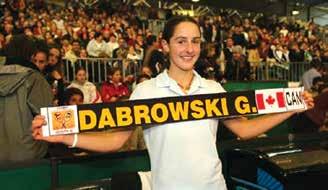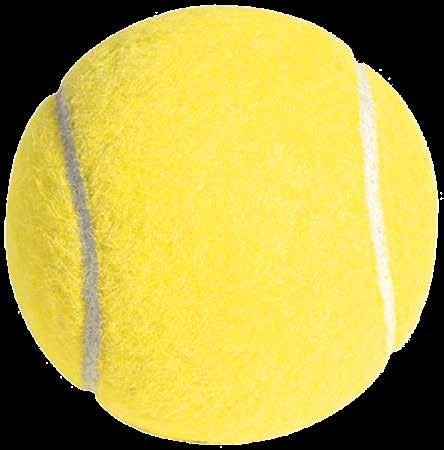
9 minute read
Your serve: tennis as a life-changer
YOUR SERVE
TENNIS AS A LIFE-CHANGER
Advertisement
BY CAMILLE LEWIS
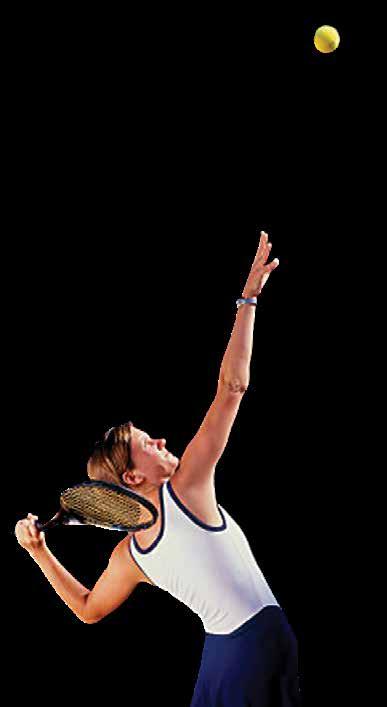
“HOW’S THE WORLD of corporate tax?” a familiar face asked in the grocery store.
“Well, no doubt it is fine and robust, but I left a couple of years ago.”
The obvious follow-up question was, what could possibly lure me away from a comfortable, professional services career? The answer: a tennis club.
It happened like this. Thirteen years with even a good company in the public accounting and corporate tax world was enough. I quit, mulled my future for a year and a half, and played tennis for recreation. Then the club where I played offered me the job of general manager. I thought back to my first summer playing there when I first arrived in Ottawa. One mid-week, 6 p.m. game stuck in my mind. Summers before that at 6 p.m. midweek, I would have been at best just starting home from the office and at worst could be heading into or out of a meeting.
The tennis job was almost a no-brainer. A lot of Canadians seem to agree. Except for the Yukon and Nunavut, all provinces and territories have their own tennis association. These associations and Tennis Canada (around since 1890!) must be doing something right because more than four million Canadians have picked up a racquet at least once in the past year, according to the association’s website.
The Ontario Tennis Association (OTA) has over 220 member clubs, helping more than 50,000 adult and child tennis players enjoy and improve their game. In Ottawa, we have the National Capital Tennis Association, with 21 member clubs. Having moved here from Toronto, I can attest to the awesome choice of clubs within 10 or 15 short minutes of everyone’s home or work.
WHY TENNIS?
• People of all ages and abilities can play, as either a competitive sport or recreation. Or both. • It is affordable and accessible. All you need is a racquet, balls, tennis shoes and a friend (or even a wall). • It’s good for your health. Tennis is a low-impact and low-injury sport, and is good for your muscles and your heart. It improves co-ordination, strength, balance and endurance. • It is the sport of a full lifetime.
Tennis programs start at pre-school and continue all the way to teams for those aged 80 and up. • It can be played outdoors for three seasons and indoors year-round. • Tennis is good for kids. It teaches hand-eye co-ordination, agility, flexibility and balance. It also promotes fair play and problem solving. • Tennis is social. Join a club and meet new people with similar ideas and an active lifestyle.
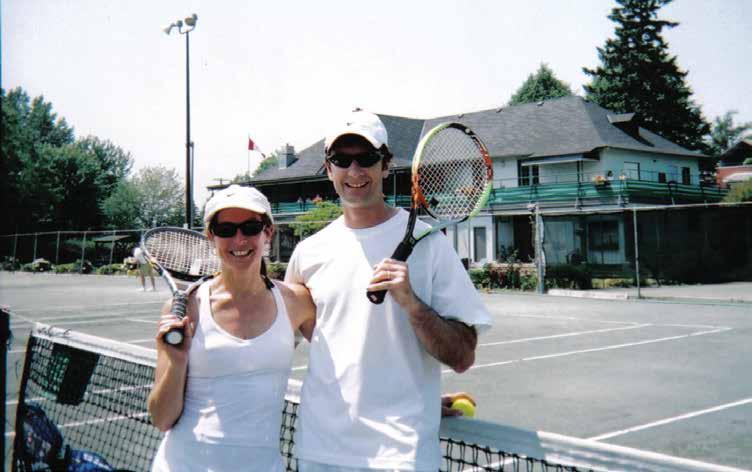
It’s a cheap therapy. Smashing a ball as hard as you can makes you forget your worries. Tennis is not time-bound, and is often available daily from 7 a.m. to 11 p.m. Tennis travels easily. Many places you visit worldwide will offer the chance to play. Programs like mini-tennis for kids or adult clinics make learning fun, fast and simple.
GETTING STARTED
A few years ago, the Ontario Tennis Association introduced the “Try, Learn, Play” concept. “Try” means just showing up and getting used to the equipment. To “try,” do this: • Pass the ball back and forth between your racquet and a friend’s. • Then bounce the ball on the racquet and on the ground. • Get used to hitting the ball in one direction, for a specified distance and in a target area. • Bounce the ball back and forth between partners many times, and then try doing it over an obstacle. • Then use a brick wall, like at your local school. Hit the ball so it strikes the wall in a precise spot, then target various heights, then angle the bounce off the wall to a partner. When new players do get on an actual tennis court, many become addicted after their first long rally (say, 10 times over the net without breaking), so clubs and programs are available in abundance to really “learn” to play, the second of
The Millcroft Inn & GET AWAY ADVERTORIAL Spa – THE Definitive Country Retreat
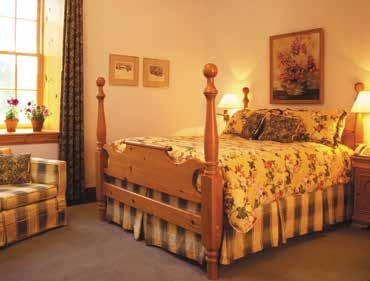
LOCATED LESS THAN an hour Northwest of Toronto and Pearson International Airport, The Millcroft Inn & Spa offers a getaway experience steeped in over 160 years of history.
Beginning in the 1840s, Shaw’s Creek (a tributary of The Credit River) was the site of a number of frame mills that harnessed the power of the flowing water to produce yarn and blankets. In the late 1800s an impressive four-storey stone knitting-mill was built, which has since been converted into The Millcroft Inn. This knitting mill continued to operate under various owners until 1965.
Over the next decade, the natural beauty and the ruggedly handsome stone buildings of the site became a focus for tourism development in the area. In the late 1970s it reemerged as The Millcroft Inn and was granted the “National Heritage Award of Honour for Heritage Preservation” by Heritage Canada in 1978.
Today, The Millcroft Inn & Spa offers 52 relaxing and beautifully appointed guest rooms – some of which include private patios, Jacuzzis or private outdoor hot tubs – award-winning ‘Four Diamond’ accommodations and cuisine, utterly unbelievable culinary experiences under the leadership of Executive Chef Roberto Fracchioni, 100 trail-lined forested acres nestled amid the breathtaking Caledon Hills, and a stateof-the-art 9,000 square foot full-service European-inspired Centre for Well-Being. The Spa features indoor and outdoor pools and hot-tubs, steam rooms, a relaxing lounge area, a broad range of services and treatments, and 17 separate treatment areas - including three private Hydrotherapy rooms: Japanese Ofuro, Vichy Shower and Swiss Shower with Blitz Guss. The Millcroft’s Swiss Shower treatments all follow the procedures developed in Germany by Dr. Kneipp – known as the ‘Grandfather of Hydrotherapy’ – who embraced the healing powers of water, using its properties of fluidity and temperature retention to develop the special treatment method which bears his name.
Guests may choose from a broad array of accommodations packages, some of which include golf at a choice of championship-calibre courses minutes away, special dining events such as Winemaker’s Dinners, or spa treatments. The Millcroft also boasts a beautiful Conference Centre making it a popular venue for weddings and corporate retreats. The Millcroft property features beautifully landscaped grounds, a network of trails - for both hiking and crosscountry skiing - that connect with the Bruce Trail System, and a shimmering waterfall that was once the source of power for the mill. The surrounding area is renowned for its natural beauty, historic towns and villages, antique shops and artist’s studios.
Whether you are looking for a relaxing escape from the stresses of daily life, a romantic getaway with your special someone, or an opportunity for you and your corporate team to recharge and re-focus, a few moments at The Millcroft will will leave little doubt that it is THE Definitive Country Retreat.


For more information visit www.millcroft.com, E-mail millcroft@millcroft.com or call 1-800-383-3976. The Millcroft Inn & Spa 55 John Street Village of Alton – Caledon, Ontario L7K 0C4 Canada.
PHOTOS BY OTTAWA TENNIS & LAWN BOWLING CLUB

the OTA stages. Like all games, tennis requires learning the basic rules, code of conduct and etiquette. First, here’s what the court looks like.
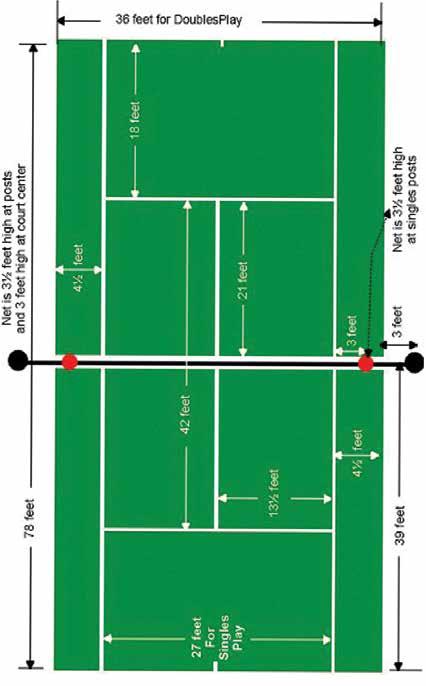
THEN THE RULES:
• The ball may be hit before it bounces or after one bounce. • When receiving a serve, there must be one bounce. • A ball landing on any part of the line is “in.” • A player (or doubles team) must score four points to win a game. You score when your opponent fails to return the ball. The first player (or doubles team) to win six games by a margin of two points wins the set. A match is usually the best two out of three sets. Hence the phrase, “game, set, match.”
TENNIS ETIQUETTE:
• Make line calls promptly and clearly. • If your racquet touches the net, you lose the point. • You must walk onto “your” court without disturbing adjacent courts. Wait for the other court’s point to finish, and then quickly cross the back of their court to get to your own. You will want to develop good basic strokes: • Forehand. If you are right- or lefthanded, you hit a shot on the right (left) side of your body. • Backhand. A shot hit on the opposite side of your “handedness.” • Overhead. A shot hit over your head while you are at the net. • Volley. A shot hit before the ball bounces, usually at the net. • Drop shot. A very soft shot hit just barely over the net. • Lob. A shot hit with any stroke high and deep into your opponent’s court. The “play” component (third in the “try, learn, play” trio) is putting your skills to test in a fun yet competitive environment. Your nearest tennis club usually offers club leagues, ladders, challenge match events, round robin tournaments, social mixers and doubles competitions. Use these opportunities to improve your tennis game and make new friends. ≈ Camille Lewis is the general manager of the Ottawa Lawn Tennis and Bowling Club. She remembers her late grandfather who introduced her to the game when she was a girl and served to her with his “wrong” hand to challenge himself and give her a chance.
OTAWA TENNIS UP AND COMER GABRIELA DABROWSKI
Age Home Coaching
Academy School Team
Tennis ambition Top Award to Date
Favorite players Hobbies
Other Events and Awards Local Award Next steps 14 Ottawa, Ontario Tony Milo – Ottawa, Canada Sonya Jeyaseelan – (touring coach) Saddlebrook, Florida, USA Sawmill Creek Elementary Member of National Tennis Team “To play among the best.”
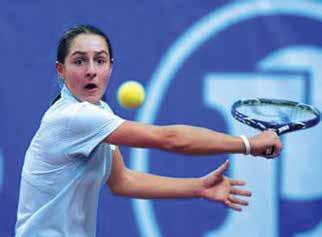
Winning the Les Petits in France in February 2006. This tournament is extremely prestigious and is considered the top tournament in the world for players Under-14. Previously, no Canadian had won until Ottawa’s Gabriela. “Martina Hingis because I always wanted to play like her.” Sports; swimming, table tennis, volleyball. Computers; housedesign. Exhibition mixed doubles match with J.McEnroe, J.Courier, A.Kournikova, J.Novotna.
Ottawa Tennis Player of the Year 2004 Aggressive tounament schedule including key tournaments such as: representing Canada at the U14 World Junior Fed Cup finals in Czech Republic in August, the U18 Canadian Nationals; numerous International Tennis Federation (ITF) tourneys.
